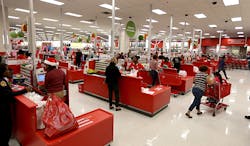As a K-Shaped Recovery Model Emerges, Consumer Spending Heavily Bifurcated
While not a large increase, a welcome one. According to Deloitte's annual holiday, retail forecast holiday retail sales are likely to increase between 1% and 1.5%.
Overall, the consulting firm projects that holiday spending will result in sales between $1,147 billion and $1,152 billion during the November-January timeframe.
E-commerce sales are expected to grow by 25% to 35%, year-over-year, during the 2020-2021 holiday season, compared to sales increasing by 14.7% in 2019.
E-commerce holiday sales are expected to generate between $182 billion and $196 billion this season.
“The lower projected holiday growth this season is not surprising given the state of the economy. While high unemployment and economic anxiety will weigh on overall retail sales this holiday season, reduced spending on pandemic-sensitive services such as restaurants and travel may help bolster retail holiday sales somewhat,” said Daniel Bachman, Deloitte’s U.S. economic forecaster. “E-commerce is likely to be a big winner because consumers have shown a clear movement towards buying online rather than at brick and mortar stores.”
A tale of two-holiday spending scenarios
The upcoming holiday retail season will be marked by unparalleled uncertainty. Taking this into account, Deloitte’s retail and distribution team see holiday sales playing out in one of two possible scenarios this season, a relatively stable year-over-year sales increase (0% to 1%) or a more significant jump (2.5% to 3.5%), both of which are lower than in years past, and will be driven by a K-shaped recovery. The formal forecast increase (between 1% and 1.5%) is a result of melding both scenarios.
“This year, one of the two-holiday scenarios will play out. Regardless of the scenario, however, the consumer’s focus on health, financial concerns and safety will result in a shift in the way they spend their holiday budget,” said Rod Sides, vice chairman, Deloitte LLP, and U.S. retail and distribution sector leader. “For retailers, this holiday season will continue to push the boundaries on the importance of online, convenience, the role of the store, and the criticalness of safe and speedy fulfillment.”
For the first scenario (0% to 1% year-over-year sales growth) to be true, consumers will continue to experience mounting anxieties, related to both their finances and health. This lack of confidence could be caused by a variety of factors, including the expiration of the unemployment insurance benefit supplement, continued school closures, and lack of an effective vaccine; as well as an increase in unemployment numbers. This would reinforce the current trends of very high savings: The current savings rate is more than double what it was last year (17.8% in July, versus 7.4% in 2019). In this scenario, consumers are less likely to spend on holiday as they are reserving funds for non-discretionary items.
On the other hand, for scenario two (2.5% to 3.5% year-over-year sales growth) to occur, consumers will experience steadily increasing confidence. This growing confidence could be a result of several factors, including an effective federal pandemic relief bill with an unemployment insurance benefit supplement, and the creation of an effective vaccine. In addition, as consumers have dramatically cut costs related to travel and experiences, these funds might be redirected to spending on holiday gifts.
